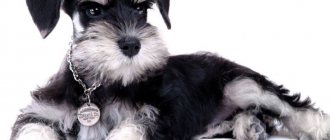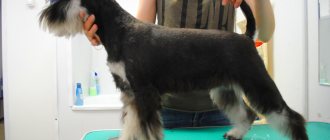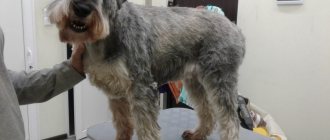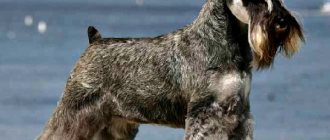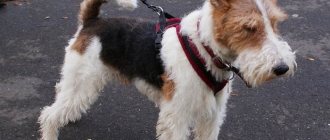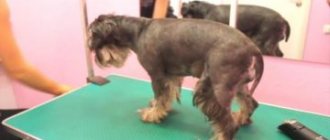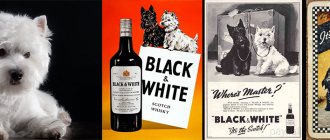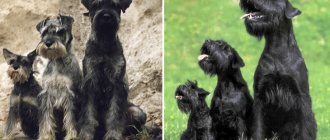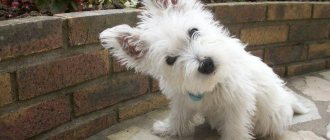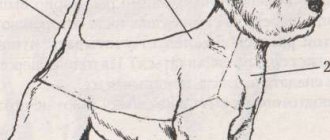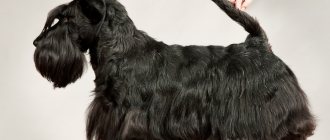The Giant Schnauzer is a large representative of the breed group of German working dogs. The hard, wire-like coat of a bearded giant is an area of special attention for a caring owner. The fur of Risen dogs has a number of delightful advantages and a whole series of burdens: huge service dogs do not shed or smell, but they require labor-intensive and rather complex grooming procedures. Hygienic grooming, trimming, rolling And a haircut Giant Schnauzer - the most important components of the life support of a huge pet.
Breed characteristics
| Short description | |
| Origin: | Germany |
| Conditions of detention: | In an apartment, insulated enclosure all year round |
| Purpose: | Watchdog, companion |
| Color: | Black, “pepper-salt” |
| Wool length: | Medium, has a characteristic beard and eyebrows; double (thick, hard undercoat and dense guard hair) |
| Adult dog size: | Height – from 60 to 70 cm (at the withers). Weight – from 35 to 47 kg. |
| Average life expectancy: | 11-12 years old |
| Walk: | 2 times a day, at least 3 hours daily |
| Physical activity needs: | Intense physical activity required; The ideal training option is to accompany the owner on a bike ride (or ski track in winter) |
| Fédération Cynologique Internationale (FIC) classification: | Group 2; Section 1 “Pinchers and Schnauzers” |
| Puppy price: | From 20 thousand rubles to 50 thousand rubles (show animals) |
Details of education
Character
Giant Schnauzer dogs are balanced, agile, courageous, incorruptible and loyal.
to its owner, hardy, unpretentious. Very active, sometimes fussy and restless. Giant Schnauzers are very fast, resilient and can instantly switch from a state of sleep to a state of combat readiness. They are strong, loyal and smart (the commands only need to be repeated once). They love to spend time actively, running and swimming.
The owner is friendly and gets along well. Partners, what do you need? This breed of dog is distinguished by its patience, at the same time it has a wayward, perky character and incredible mobility. It won't be difficult for a stranger to piss off a dog. If you even slightly raise your voice at its owner or touch him in a not very friendly manner, then be prepared to take the blow of an angry guard who sees you as the main enemy. One of the main rules for the Giant Schnauzer is to protect the family, and if the danger is great, then nothing will stop him.
Education and training
Training is very important for a Giant Schnauzer! If the dog owner himself cannot or
If he doesn’t want to deal with his dog, you should sign up for classes with a dog trainer at a specialized school. Regular and proper training at an early age, from the very first day in the house, is the key to turning a naughty puppy into a well-mannered, adequate adult dog. The dog needs to be constantly upgraded, teaching new commands and skills.
This may sound ridiculous, but those owners who have owned at least one dog will agree: it is necessary and important to talk to intelligent dog breeds. And the Giant Schnauzer is no exception. Yes, dogs don’t talk, but once you look into their eyes, everything becomes clear without words. The Giant Schnauzer perfectly combines such qualities as cheerfulness and perseverance, but without classes and exercises, everything very quickly tends to zero.
It is better to train through play, without physical force, screaming and psychological humiliation. Do not indulge your pet and do not allow your commands to be ignored. Long walks in the fresh air and significant physical activity are vital for the Giant Schnauzer, for example, regular jogging in the summer and towing the owner on skis in the winter. But it should be remembered that it is not recommended to give such loads until one and a half years, because The dog’s ligaments are not yet strong enough.
ADVICE: It is better to do training when the dog has had enough play and runs around the street, having lost excess energy. Thus, you will see that the pet perceives the instructions given to it much better.
Giant Schnauzers tend to trust strangers, they have an excellent memory for everyone they have ever seen, and they are not wary of them. And very often in vain. Therefore, try to prevent your dog from excessively communicating with strangers, but it is also not recommended to turn your dog against it. The pet must always be controlled, always reminded that the owner is in front of him and that obedience must be ironclad.
Important: remember that the Giant Schnauzer is not a house toy, and training is an important part of life for his health and full development.
History of the origin of the species
There is no reliable data on the origin of Giant Schnauzers. Most researchers of the pedigree of this breed agree that the earliest information about “dogs with a beard” appears in Germany during the Middle Ages. For example, the sketches of the painter Albrecht Durer (late 15th century) contain images of dogs of a similar type.
The place where these dogs appeared is considered to be two German regions with the central cities of Stuttgart and Munich.
The ancestors of the breed were probably ordinary village dogs that helped people herd and protect herds. Over the course of several centuries, there was a natural mixture of different types of German Shepherd Dogs, as well as artificial crossing with Flemish Shepherds and Great Danes. As a result, this led to the formation of a large individual that has recognizable external characteristics.
By the beginning of the 20th century, the main characteristics of the dog’s exterior had been formed, and the standard of the Giant Schnauzer was approved.
Interesting Facts
Giant Schnauzers are interesting not only for their working qualities. Over the years of the breed’s existence, many interesting facts have been associated with it:
- At first, Rizens were called beer or bear schnauzers. The first name was assigned to the breed due to the fact that the dogs often guarded carts with beer. The second is due to the fact that dogs were involved in hunting bears.
- The modern name of the breed has German roots and consists of two words – riesen (giant) and schnauzer (muzzle).
- Giant Schnauzers appeared in the USSR only in the 1970s. The first purebred littermates Akbar and Anni f. Raakzee were brought to the leading nursery “Krasnaya Zvezda” and became the founders of the domestic line of the breed.
Distinctive features
The Zenschnauzer was recognized by the FCI in 1955, classified in Group 2, Section 1 “Pinchers and Schnauzers” and has the following distinctive features:
- The head is large, heavy, powerful, somewhat elongated; gently tapers towards the nose; Shape: triangle with equal sides.
- The ears are set high, triangular in shape, cropped.
- The eyes are oval-shaped, set straight; color dark brown.
- The stop is clearly defined, noticeably outlined by thick eyebrows.
- The muzzle is wedge-shaped, slightly smoothed, with a characteristic beard.
- The jaws are powerful; cheekbones are well developed.
- The nose is noticeable, large, black, protruding.
- The lips are black (with coats of both colors).
- The teeth are massive, white, a full set of 42, the fangs are clearly defined; bite .
- The physique is proportional, square.
- The muscles are sculpted.
- The neck is massive, proportional to the body, set at an angle of 45°, no wrinkles.
- The croup is strong, lean (dry constitution), strong.
- The chest is oval-shaped, of medium width.
- The stomach is tucked.
- The line of the back is sloping; loin is short.
- The limbs are straight, the hind legs are slightly shorter than the front ones.
- The movements are energetic, light, stable.
- The coat is of medium length, there is a characteristic beard and eyebrows; double (thick, hard undercoat and dense guard hair); color black, “pepper-salt” (undercoat gray or silver).
- The tail is short, set high, docked at the level of 2 or 3 vertebrae.
Photo of an adult dog
Photos of puppies
Features of character and behavior
The Giant Schnauzer is an excellent example of a guard dog with phenomenal working characteristics . Character – calm, self-possessed, flexible. The dog combines obedience, patience and high mobility. Together with intelligence and an exceptional ability to learn commands, these qualities make the Giant Schnauzer an ideal protector and reliable companion. The breed is classified as a service breed, which means that Giant Schnauzers do an excellent job of protecting and guarding both humans and the entrusted territory.
Given the extraordinary abilities and extraordinary need for activity, it is not recommended for inexperienced owners to own a dog. Lack of breed-appropriate training and exercise can lead to obedience problems .
Advantages
The Giant Schnauzer has numerous advantages:
- Has high intelligence scores, is inquisitive, and self-confident.
- Endowed with uniquely high performance and endurance.
- Excellently trainable, active, capable of quickly learning commands.
- It is one of the best among guard dogs, since along with protective qualities it has a balanced temperament.
- Does not react to extraneous sounds and movements by barking for no reason.
- He makes contact easily, but is cautious with strangers, especially when performing guard duties.
- He is attentive to the owner’s “mood” and adapts to his condition.
- Always ready to accompany the owner; during walks he vigilantly watches those around him, but does not show aggression.
- Suitable for families with children, with whom he shows unlimited patience and friendliness.
- Gets along well with other pets.
- Does not have a typical dog odor.
Flaws
The disadvantages usually include the following:
- The need for daily long-term (many hours) exercises, including both physical activity and practicing various commands; in the absence of appropriate exercises, the Giant Schnauzer turns into a sad, unhappy creature;
- Not suitable for keeping in a small apartment or studio;
- Not suitable for inexperienced owners, as well as people with a soft and calm character; The Giant Schnauzer requires firmness in education and active participation of the owner;
- Given its size, it is not recommended for older people to have a pet of this breed;
- Grooming requires significant financial investments, as well as time (visiting a professional groomer).
A dog is absolutely not suitable for people who do not have the opportunity to devote a sufficient amount of time and effort to training their pet and who lead a sedentary lifestyle.
Everyday grooming
To maintain the aesthetic appearance and vigorous vitality of your pet, you must:
- carefully comb the giant dog, eliminating tangling of the base coat, stopping the matting of the thick undercoat, massaging the upper layers of the dermis;
- Rinse and thoroughly dry your pet’s bearded muzzle after each meal. Frequent full bathing of the dog is not recommended: even veterinary detergents negatively affect the quality and structure of the coat;
- regularly examine your pet’s eyes and, if necessary, remove purulent discharge from the tear ducts;
- wipe the ears, clean the ear canals;
- carry out dental sanitation, clean fangs from plaque and tartar formations;
- Trim the animal's claws as they grow.
Care and maintenance
A Giant Schnauzer can live with equal success both in an apartment and in an enclosure on the site of a country house. The exception is small-sized apartments and studios, where organizing enough space is often difficult. Keeping them outside is only possible in an insulated enclosure with additional heating in winter. The enclosure or booth must be installed on a wooden foundation (raised 20 cm from the surface), under a canopy and in a
dry place.
The last option for placing a Giant Schnauzer should be used as a last resort, since short hair cannot save the dog from severe frost.
In addition, placing the dog outside does not allow for close contact between the dog and the owner. And this is an indispensable condition for the formation of a calm and balanced character of the Giant Schnauzer.
Keeping a Giant Schnauzer on a leash is not allowed.
- bathed as needed. Usually 1-2 times a year is enough for the pet to have a well-groomed and tidy appearance. Only the face of the Giant Schnauzer requires special attention. It must be wiped after each feeding.
- eyes require weekly examination for discharge. But even in their absence, it is recommended to visit a specialized doctor once every 6 months. Giant Schnauzers are susceptible to various ophthalmological diseases.
- The ears also require inspection once a week. In addition to dust and dirt, it is necessary to remove excess hair from the ears that covers the ear canal.
- claws are trimmed as they grow. Often, due to prolonged loads, they wear down without intervention from the owner.
Nutrition
It is recommended that the Giant Schnauzer's diet be based on natural products. This is meat, cottage cheese, kefir, cereals and vegetables . High activity and high weight, which an adult dog must achieve, require protein food almost from birth.
The puppy's feeding regimen is subject to the following basic requirements:
- The portion should be appropriate for the puppy’s age; This can be determined by behavior - if the baby eats the amount and peacefully goes to his place, without requiring supplements, the amount is selected correctly;
- There are no night feedings in the nutrition plan;
- During the daytime, it is recommended to give food at certain hours; the first appointment is usually no later than 7 am, the last appointment is no later than 21-22 o’clock;
- Cottage cheese and porridge are given in the first half of the day; meat and vegetables - in evening feedings.
We recommend that you read a detailed article on the topic: “How and what to feed a dog: types and characteristics of nutrition.”
The number of feedings depends on the age of the pet:
- 1-3 months – 5-6 feedings; volume 200-300g;
- 3-6 months – 4 feedings; volume 700-800g;
- 6-12 months – 3 feedings; volume 1-1.2 l.
Upon reaching the age of 1 year, the dog is considered an adult and is transferred to 2 meals a day. The diet should consist of meat, kefir and vegetables. The order of submission remains the same. Morning feeding consists of dairy food; In the evening, meat and vegetables are given.
With a natural diet, the pet additionally needs to take vitamins. Typically, such courses are prescribed 1-2 times a year. The dosage and name of the complex are selected individually.
Dry food is recommended for use in the diet of older Giant Schnauzers. Starting from 7-8 years old, they require increased amounts of vitamins and minerals.
Premium+ dry food usually contains the necessary additives in the right ratio.
You can use ROYAL CANIN, EUKANUBA, PROPLAN (PURINA), BOSCH, HILL`S, HOLISTIC. The feeding volume is indicated by the manufacturer on the packaging. The dosage should not be exceeded.
Regardless of the type of food, your pet should always have fresh water available.
Health
Giant Schnauzers have excellent health . These are strong and hardy dogs, which are distinguished by strong immunity. The condition of the pet’s body usually does not cause concern for a long time, and special measures are not required to maintain health.
Good physical characteristics allow dogs to be independent of environmental conditions. The performance of the Giant Schnauzer is at a very high level; The returns from these dogs are amazing.
Life expectancy under proper loads can be up to 14 years.
Vaccinations
The vaccination schedule for Giant Schnauzer puppies does not differ from vaccination measures for puppies of other breeds. The first vaccine is given at 2 months, and again after 21 days. It is used as comprehensive protection against plague, parainfluenza, hepatitis and parvovirus enteritis.
At 6 months, a rabies vaccine and a third complex vaccine against major infectious diseases are given. If at this moment the dog has a change of teeth, vaccination is shifted to a later period.
Starting from 12 months, the animal is revaccinated annually.
Important article on the topic: “Everything you need to know about dog vaccinations.”
Diseases
In general, the health of the Giant Schnauzer does not require increased attention from the owner. Diseases to which representatives of this breed are susceptible are limited to diseases characteristic of large dogs:
- Hip dysplasia;
- Bloating (often due to poor diet and exercise habits);
- Atopic dermatitis;
- Diabetes (in old age).
In addition, Giant Schnauzers are susceptible to a number of ophthalmological diseases: retinal atrophy, glaucoma, cataracts.
Walk
Giant Schnauzers should be able to spend long periods of time each day in active activities.
Walking your pet must be organized at least 2 times a day, the duration of each walk is at least 1.5 hours.
Dogs are highly active and very mobile. Therefore, the walk should consist mainly of high-intensity physical activity. The best option for a Giant Schnauzer would be to accompany the owner on a bike ride.
To stimulate brain activity, the dog must be trained to train “intellectual” commands. Basically we are talking about search games in which the tasks “sniff”, “search”, “bring” are practiced.
Grooming
The absence of heavy shedding is an undoubted advantage of Giant Schnauzers . Short wool dries quickly, gets dirty a little, and does not tangle.
However, it would be wrong to think that pets' fur does not need care. On the contrary, dense guard hair and a thick and coarse undercoat require frequent combing - at least once a week. This can be done using a stiff bristle brush and a furminator, which easily removes dead hair. It is recommended to comb your beard and eyebrows at least 3-4 times a week using a simple single-row comb . Additionally, it is necessary to trim the hair around the pads.
In addition to regular care, the Giant Schnauzer's coat undergoes a special procedure at least 2 times a year. We are talking about trimming, which should be entrusted to a professional. This is especially important if the dog is planned to participate in exhibitions.
Dogs usually react with displeasure to manipulations associated with brushing, bathing and grooming. Giant Schnauzers are no exception. Therefore, it is necessary to accustom your pet to these procedures from the first days of life. To prevent your baby from being afraid of the table, bath or scissors, you can use treats to encourage calm behavior .
DIY trimming
If you have experience, you can carry out the trimming procedure yourself.
It is recommended to carry out the rolling procedure at home. It involves manually plucking mature hair from the dog's body. In this way, up to 20% of the fur is removed. This manipulation of the Giant Schnauzer's fur is carried out once every 2-3 weeks. For this, in addition to a brush and a furminator, you will need a clipper and scissors.
The machine is used to cut off excess hair on the neck, under the tail (on the butt).
The hair on the ears and head is first trimmed with ordinary scissors. A hygienic haircut is carried out in the groin and paws. To give it an exhibition look, use special thinning knives (or scissors). They allow you to create beautiful transitions of hair of different lengths.
Full trimming is carried out 2 times a year, during seasonal molting.
After hair removal, it is recommended to treat the Giant Schnauzer's skin with antiseptic preparations until new hair appears.
Giant Schnauzer haircut pattern
Preparing the exterior of a Giant Schnauzer for an exhibition consists of two stages.
2 months before the exhibition the following procedures are carried out:
- Plucking dead hair on the neck, body and hind legs (including the undercoat);
- Intensive combing with a furminator;
- Trimming excess hair on the throat, tail, butt, and groin area.
2 weeks before the exhibition, the remaining excess hair is plucked out and the haircut is carried out directly according to the following scheme:
- Longer hair from the lower half of the chest is shortened with thinning scissors towards the belly and groin, the transition should be as smooth as possible;
- The hair on the tail, around the anus and genitals is cut off completely;
- The hair on the thighs (outer side) is plucked to such an extent that the muscle relief is clearly expressed;
- The fur on the inner thighs is trimmed;
- Hair is not removed from the forelimbs (except for individual hairs sticking out);
- On the throat, six is cut extremely short, from a few millimeters in the lip area to longer in the upper part of the neck and shoulder blades;
- The hair on the ears is shortened (inside and outside), in the ear canal it is completely plucked;
- The hair on the forehead to the eyebrows, as well as on the cheekbones, is cut very short;
- From the hair on the eyebrows, a “bang” is created in the form of a triangle, up to the middle of the muzzle;
- The beard is combed downward, while the hair on the side of the jaws is smoothly shortened;
- After cutting all parts, the general appearance of the dog is assessed, and the transitions in those areas where hair of different lengths are formed are corrected.
Terminology
The modern Russian canine school loves foreign words: the professional communication of judges, breeders and exterior experts is full of borrowings. This is more familiar and convenient for professionals, while owners have to adapt to the situation, study the slang, study the jargon. For equal communication, it is enough to understand and “adopt” just a few terms:
- Grooming - everyday care . Grooming includes a wide range of procedures: the entire range of work with the coat, sanitation of the eyes (tear ducts), ears, teeth, trimming of claws;
- Trimming - “artificial shedding”, removal of dead fur by plucking . Grooming experts declare the procedure as an art, a complex procedure that not only improves the appearance (exterior) of the animal, but also has a beneficial effect on the condition of the skin and coat of the Giant Schnauzer . Groomers consider several types of trimming: regular general, zone rolling and complex show trimming.
- Cosmetic haircut is a model formation of the decorative spine of a Giant Schnauzer. Hairclipping is a subsection of exhibition grooming. A few weeks before the exhibition catwalk, the Giant Schnauzer undergoes a series of procedures: the dog is zoned plucked in several stages, and a couple of days before the exhibition, the hair (smoothing out the transitions between the treated zones-distances).
Mating
Breeding a Giant Schnauzer is associated with certain difficulties due to the small number of high-quality representatives of this breed.
To obtain offspring with a stable psyche, the following points must be taken into account when mating:
- Manufacturer's fame (pedigree), success at exhibitions;
- The character of the dog should be even, patient and obedient;
- Performance characteristics of the individual (checking is carried out at training sites).
Owners of bitches need to prepare a place for keeping puppies in advance. This breed has numerous litters, up to 12 pieces.
Otherwise, mating is subject to the basic rules and is carried out:
- At the age of no earlier than 18-24 months, in the interval from 11 to 14 days of estrus;
- In the morning;
- On empty stomach;
- In the dog's territory.
Read a detailed article on the topic: “Everything you need to know about breeding dogs: appropriate age, what to do if it doesn’t work out, rules and tips.”
Diseases of Giant Schnauzers
Increased immunity practically eliminates seasonal diseases, but if the dog is kept incorrectly, in a poorly equipped enclosure and a cold kennel, it may suffer from kidney and urinary diseases. The Giant Schnauzer breed is not immune to hereditary diseases, including diabetes mellitus and other endocrine pathologies, hip dysplasia, and cataracts. Therefore, those who want to have a healthy dog are recommended to purchase a puppy from breeders who test for the presence of genetic diseases.
Key points in training
Giant Schnauzers have excellent intelligence and quickly grasp what their owner or dog handler requires of them. Therefore, training these animals is a pleasure. They are patient, obedient, and rarely conflict.
In order to quickly establish contact with your pet, it is recommended to include an element of novelty in each activity, coming up with interesting search tasks for the Giant Schnauzer.
It is better to practice basic commands in the second part of the walk, after the dog has used up an extraordinary charge of energy.
Read about how to properly train a dog in the article: “Training a puppy: effective methods from dog handlers, learning commands at home.”
Nickname for a Giant Schnauzer
You can’t call it a devoted friend, assistant, watchman, security guard and bloodhound all rolled into one. The Giant Schnauzer dog breed, its history and reputation impose their own requirements on the choice of nickname. Classic German nicknames are in great use - biting, rude, with a lot of hissing and other sounds characteristic of this language: Arthur, Achi, Wolf, Hertz, Kaiser and others, this applies to male dogs. The bitch can be called Aksa, Vilda, Zelda, Hilda. You can choose something from famous films, TV series and even cartoons: Gromit, Poof, Lady, Nana.
How to choose a puppy
Before you decide to choose a puppy of this particular breed, you need to carefully familiarize yourself with the features of caring for and keeping your pet. Giant Schnauzers are generally unpretentious, but making their coat look beautiful will require a lot of effort, time and money. It is also necessary to remember that these dogs are characterized by increased activity. Each walk should last at least 1.5 hours.
If the nuances do not bother you, when choosing a puppy, it is recommended to be guided by the following:
- Purchase only from trusted breeders;
- Conduct an assessment of behavior and physical characteristics - the puppy must be active, sociable, have a good appetite (weight at 2 months should be 5-6 kg);
- The color of the puppy is black or “pepper and salt” (the limbs have a light or grayish tint);
- The exterior must correspond to the approved parameters, including: hard, short hair, black claws, rectangular skull, flat back.
The Giant Schnauzer combines incredible strength and power, on the one hand, and goodwill and equanimity, on the other hand. It is the combination of these traits that makes them popular and desirable dogs.
4.7 / 5 ( 3 voices)
Giant Schnauzer ear cropping
As soon as Giant Schnauzer puppies reach the age of 1.5-3 months, their ears are cropped. The operation is performed by an experienced specialist who takes into account the density of the ear cartilage, the shape and size of the head and other parameters. It is recommended to maintain an interval of two weeks between surgery and vaccinations. At the end of the work, the puppy is given a gauze bandage, and then it is recommended to wear a special collar so that the baby does not scratch the stitches. The wounds must be treated with a special antibacterial agent, and when the stitches are removed, you can begin to install the ears.
